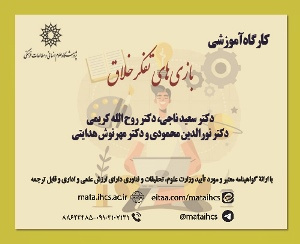بررسی تحلیلی نقشمایه های نمادین و اساطیری در هنر کلماکره لرستان (مقاله علمی وزارت علوم)
درجه علمی: نشریه علمی (وزارت علوم)
آرشیو
چکیده
گنجینهکلماکره بهطوراتفاقیدرسال 1368 ه.ش توسطیکشکارچیمحلیدر غار کلماکره واقعدر 20 کیلومتریشمالغربشهرستانپلدختردراستان لرستان کشف شد. اشیاء این گنجینهشاملانواع ظروف،ریتون ها،مجسمه هایانسانیوحیوانی،صورتک ها،پلاک ها،زیورآلاتو...از جنس نقره و طلا استکه متعلق به دوران ایلام نو (هزاره اول ق.م) هستند.در پژوهشی که منجر به شناسایی و مستندسازی اشیای گنجینه غار کلماکره لرستان در موزه های داخل و خارج از ایران شد، نقوش اساطیری و نمادین روی اشیاء و چگونگی تحول باورهای آئینی و مذهبی آنها بررسی و تجزیه و تحلیل شد. در طی این پژوهش بخشی از حلقه ارتباطی فرهنگی/تاریخی سازندگان این اشیاء از نظر تکنیک هنر فلزکاری و نمادشناسی با سایر اقوام ایرانی و تمدن های همجوار در این دوره تاریخی و پس از آن مقایسه و بررسی شد. مفاهیم و بن مایه های نمادین و اساطیریآفرینش(نبرد نور و تاریکی)، چهره هاینمادین (شاهوقهرمان)، موجوداتاساطیری (موجوداتفراطبیعی و جانوران)، عناصر طبیعت (گیاهان، رستنی ها وآب)، ابزارهای تشریفاتی شگفتونقوش اساطیری روی اشیاء، همه تبیین کننده افکار، عقاید و باورهای صاحبان و سازندگان آنهاست که حضور قدرت های ماوراءالطبیعه در آنها مشهود است. این پژوهش به روش تحلیلی استقرایی و با تأکید بر مطالعه نقوش و فرم اشیاء انجام شده است.همچنین از روش مشاهدهومراجعه به موزه های داخل کشور و جستجوی اینترنتی در وب سایتموزه های خارجی،روش مقایسه ای و بررسی اسناد و متون تاریخی استفاده شده است.Analytical Research of Symbolic and Mythological Motifs in Lorestan Kalmakarreh Art
The Hoard of Kalmakarreh includes hundreds of golden and silver wares that were incidentally discovered by a local hunter in 1987 at a northwest 20 kilometer distance to Pol-e Dokhtar in province of Lorestan. The collection includes a variety of dishes, Raytheon, human and animal sculptures, masks, plaques, jewelry,… that belongs to the Neo- Elamite (first millennium BC). This research led to the identification and documentation of objects in the Museum of the kalmakarreh Cave Treasure. It also investigates and analyzes the mythological motifs and symbolic ritual objects and religious beliefs and evolution were investigated. In this research, the link is part of the cultural/historical creators of these objects. Technically, metal art and symbology with other Iranian tribes and neighboring civilizations in the historical period, and then was evaluated. Concepts and symbolic motifs and mythological creature, symbolic figures (king and hero), mythological beings (supernatural beings and animals), the elements of nature (plants, herb and water), a wonderful ceremonial tools and objects of mythological beliefs and rituals these treasures, all explanations of thoughts, ideas and beliefs of their creators and owners, and their presence is evident in the metaphysical powers. The fundamental institutional Kalmakarreh mythological narrative of creation and negation of each other in a battle of light and dark and wonderful nature that inspired the creators of these works is amazing. It should be noted that this belief has never completely died out. This trend can be seen as aggressive in Kalmakarreh art with a new face and a tone, even up to today's the struggle between good and evil, odern belief is common Lor. These things are not just a simple artwork, In each of them, but there is a world of thoughts, beliefs, industry, art, lifestyle, beliefs and lies of any kind. The main question in this article form, technique and application of this kind of things? And that the objects of decoration on them is comparable to the concept of symbolic and mythical peoples them? In this study, analytic and inductive methods with emphasis on study designs and shape of objects is done. Observation, as well as visiting museums in the country and Internet search websites in foreign museums, comparative and historical documents and texts used. Kalmakarreh Cave Treasure classification of objects based on shape and applied to two kinds of concepts and mythological motifs are taken. This type of classification is both descriptive and interpretive aspects. The application is divided into two metal containers, decorative containers (ceremonial)'ve shared and consumed. Appearance of Neo-Elamite inscriptions on some of these objects reveals their connection with the Neo-Elamite cultural horizon. Their unique specification is that they introduce a new dynasty in the western Iran in the 1st millennium BC that, in turn, plays a vital role for archeological researches on the outset of the Iranian historical era. Samaturra (Samati) rulers (Kalmakarreh Cave Treasure owners) as one of the independent states to Elam that emirates in the south of Lorestān in the 7th and the early 6th centuries BC .





